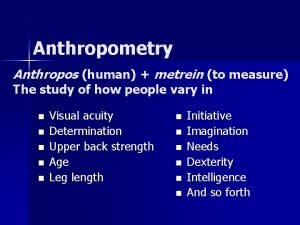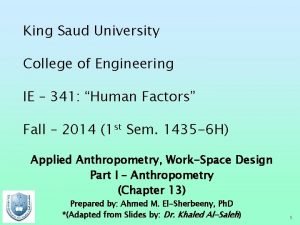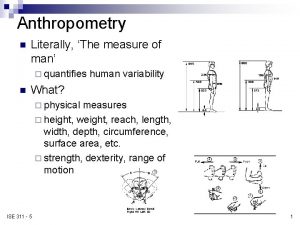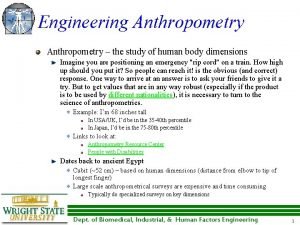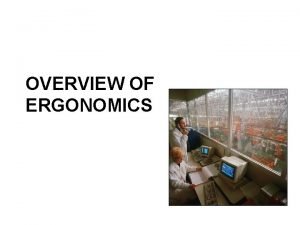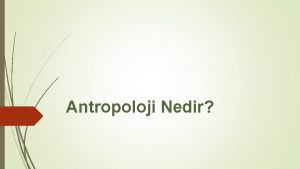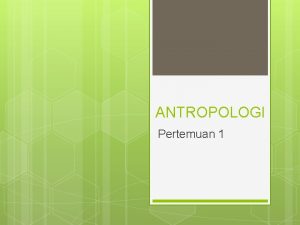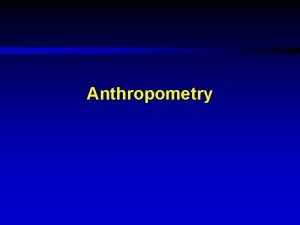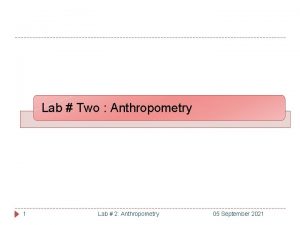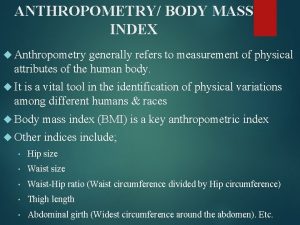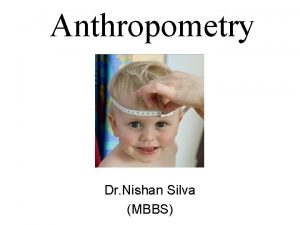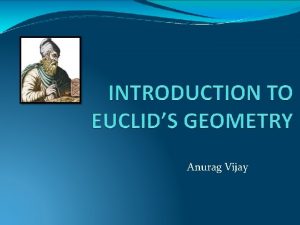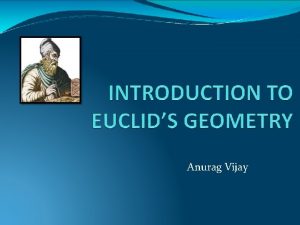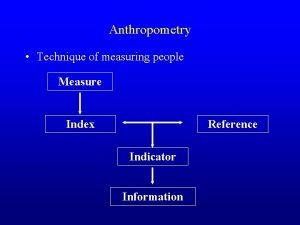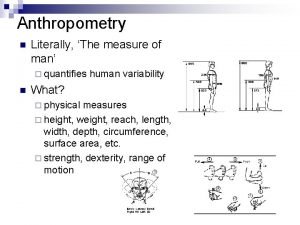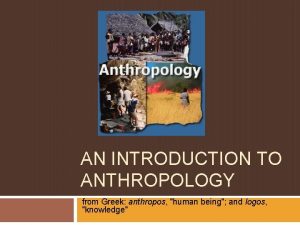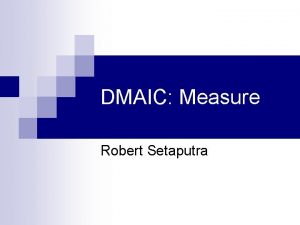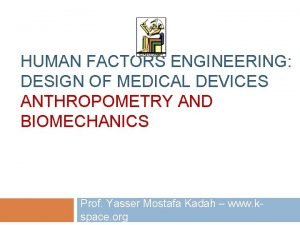Anthropometry Anthropos human metrein to measure The study




















- Slides: 20

Anthropometry Anthropos (human) + metrein (to measure) The study of how people vary in n n Visual acuity Determination Upper back strength Age Leg length n n n Initiative Imagination Needs Dexterity Intelligence And so forth

Engineering Anthropometry n Physical body size – Static n n Two dimensional Three dimensional – Functional n n Strength – Isometric – Dynamic – isotonic, isokinetic, iso-inertial etc. – MVC joint torques Biomechanical / inertial properties – – Segment mass Segment center of gravity locations Muscle attachment sites and lever arms Failure stresses of ligaments, tendons, bones etc.

Selection vs. Job Modification n Two basic strategies: – Selection—fit the person to the job. – Job modification—fit the job to the person n Follow the second strategy: the key to progress has been to challenge the environment.

Exclude as Few as Possible Minimizes the number of people excluded, which tends to make the job easier for everyone n Balance seriousness of exclusion with cost of inclusion n

Excluded Percentile n May be: – Upper (a door tall people can’t fit under) – Lower (a task requiring manual dexterity) – Both (intelligence test for factory job) n Designing for the mean may exclude half the population.

Population Dimensions Define the user population. n Consider the source of population dimensions n – Male/female – Military/civilian – Age – Ethnicity – Occupation

Body Position Descriptions n Planes – Saggital – divides the body into left and right half (medial/lateral) – Coronal – divides the body into front and back half (anterior/posterior) – Transverse – divides the body into top and bottom half (superior/inferior) n Limbs – Proximal: close to torso – Distal: further from torso

Wrist/Hand Motions n n n Flexion – closes the joint angle from neutral position. Extension – opens the joint angle from neutral position. Adduction/ abduction – opens and closes laterally

Wrist/Hand Motions n Radial deviation/ulnar deviation

Wrist/Hand Motions n Pronation/supination

Body Dimensions n Sample 95 th percentile dimensions (cm) of nude U. S. adult civilians. Female Male Stature (height) Eye height Thigh height (sitting) Forward reach Hip breadth (sitting) Weight (kg) 173. 73 162. 13 18. 02 79. 67 43. 22 84. 8 186. 65 174. 29 18. 99 86. 70 41. 16 99. 3

Variations in body dimensions n n n Most body dimensions do not correlate well with stature, coefficient of determination R 2 is less than 50%. So be careful when predicting other dimensions from stature. Individual segment weights are calculated from total body weight. In absence of data female may be estimated as 93% of male if no data available

Variations in Strength n n Females average 63% isometric strength of males. Strength of specific muscle groups varies depending on – – – n Limb: Leg approx. 3 times strength of arm Direction exerted: Strength may decrease by 50% Preferred hand/arm/leg: Strength may vary by 40– 50% Left and right leg strengths do not differ appreciably.

Other Characteristics Age n Personal space n

Age of Workforce Birth rate is declining. n Additional workers must come from immigration n Longer work hours n Delayed retirement n Older workers must be considered. n

Personal Space Intimate (0 – 18 in. ) n Personal (18 – 48 in. ) n Social (4 – 12 ft) n Public (> 12 ft) n Boundaries vary with gender, familiarity, and culture. n

Statistical Calculations Normal distribution provides a close approximation. n Mean (average) is 50 th percentile. n Normal distribution is symmetrical. n Absolute variability given by standard deviation. n Relative variability given by coefficient of variation. n

Normal Distribution

Distribution Calculations n To Find Percentile – Find difference from the mean (subtract). – Convert to standard units (divide by standard deviation). – Use table to find percentile.

Distribution Calculations n To Find Dimension – Use table to find number of standard units from mean. – Convert to dimension measure (multiply by standard deviation). – Add or subtract mean.
 Metrein
Metrein Static and dynamic anthropometry
Static and dynamic anthropometry Anthropometry
Anthropometry L
L Static and dynamic anthropometry
Static and dynamic anthropometry Engineering anthropometry
Engineering anthropometry Anthropometry
Anthropometry Anthropos ne demek
Anthropos ne demek Anthropos man logos
Anthropos man logos Antropos dan logos
Antropos dan logos Ginecologia
Ginecologia Is measure for measure a comedy
Is measure for measure a comedy Measures air temperature
Measures air temperature Hát kết hợp bộ gõ cơ thể
Hát kết hợp bộ gõ cơ thể Bổ thể
Bổ thể Tỉ lệ cơ thể trẻ em
Tỉ lệ cơ thể trẻ em Gấu đi như thế nào
Gấu đi như thế nào Chụp tư thế worms-breton
Chụp tư thế worms-breton Hát lên người ơi
Hát lên người ơi Môn thể thao bắt đầu bằng từ đua
Môn thể thao bắt đầu bằng từ đua
